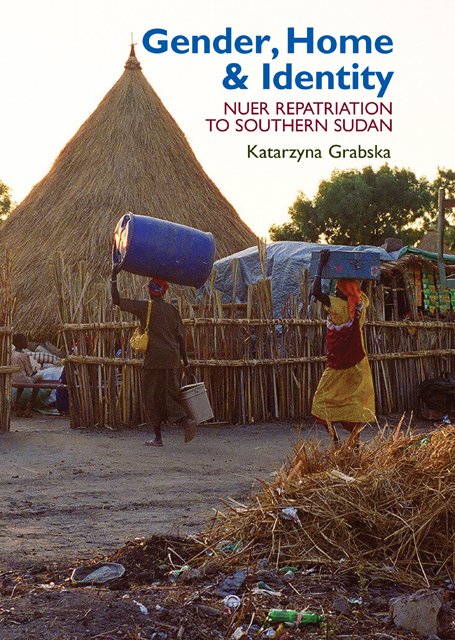Book contents
- Frontmatter
- Contents
- List of Maps and Photographs
- Preface
- Acknowledgements
- Glossary of Nuer Terms
- Acronyms
- 1 Returnee Dilemmas: Dangerous Trousers and Threatening Mini-skirts
- 2 Jiom – Season of Fighting and Running: Conflict, Mobility, Gender
- 3 Mai – Season of Displacement: Becoming ‘Modern’ in Kakuma
- 4 Rwil – Season of ‘Returns’
- 5 Season of Settling-in: Land and Livelihoods
- 6 Tot – Gendered Emplacement Identities, Ideologies and Marriage
- 7 Returnees as Visitors and the Nuer Community: Where Do We Go From Here?
- Epilogue
- Bibliography
- Index
- Eastern African Studies
1 - Returnee Dilemmas: Dangerous Trousers and Threatening Mini-skirts
Published online by Cambridge University Press: 24 February 2023
- Frontmatter
- Contents
- List of Maps and Photographs
- Preface
- Acknowledgements
- Glossary of Nuer Terms
- Acronyms
- 1 Returnee Dilemmas: Dangerous Trousers and Threatening Mini-skirts
- 2 Jiom – Season of Fighting and Running: Conflict, Mobility, Gender
- 3 Mai – Season of Displacement: Becoming ‘Modern’ in Kakuma
- 4 Rwil – Season of ‘Returns’
- 5 Season of Settling-in: Land and Livelihoods
- 6 Tot – Gendered Emplacement Identities, Ideologies and Marriage
- 7 Returnees as Visitors and the Nuer Community: Where Do We Go From Here?
- Epilogue
- Bibliography
- Index
- Eastern African Studies
Summary
When, after years of displacement Nyakuol, Nyariek and Kuok arrived in Lϵr, a Nuer town in southern Sudan’s Greater Upper Nile region, they were faced with the dilemma of finding long-lost relatives, settling in and confronting local expectations of proper behaviour as ‘real’ Nuer women and men. Like many others displaced during the 22-year-long second civil war in southern Sudan (1983–2005),2 they had spent most of their lives in refugee camps. In the aftermath of the 2005 peace agreement between the Sudanese government in Khartoum and the Sudan People’s Liberation Army/Movement (SPLA/M) – the main southern Sudanese rebel organisation that had fought against northern domination since 1983 – they repatriated to post-war Nuerland. This place, which they barely remembered or knew, was supposed to become ‘home’. Yet, due to their diverse experiences during wars and flight and the changes that had taken place in southern Sudan, they often felt estranged within their own homes.
Nyakuol, a widow in her forties, Kuok, a slim, boyish-looking young man in his late twenties, and Nyariek, an 18-year-old woman, stood out. Nyakuol wore a wig purchased in Nairobi and was always elegantly dressed in Kenyan-made clothes. Kuok wore a bright green shirt and well-ironed trousers, while Nyariek sported tight trousers and red hair extensions. This was unprecedented in Lϵr, where men mostly wore torn sports clothes or cast-off military uniforms and carried spears or guns, and women, hidden in their homesteads, had shaved heads and wore long dresses.
It was not only their appearance that distinguished Nyakuol, Kuok and Nyariek. Daughter of the first ever chief of Lϵr, Nyakuol had married a high-ranking SPLA officer at the age of fifteen and joined him in the military camps in Ethiopia in 1998. Her husband was one of the SPLA’s founding members. She and her children moved frequently, following her husband, eventually finding refuge in Kenya’s Kakuma refugee camp in 1994. After her husband died in what she described as ‘unexplained circumstances’, she stayed in Kenya so that her children could continue to access education and health services. Becoming a camp leader, she attended income-generating and gender-awareness training courses and started her own brewing business to sustain her family.
- Type
- Chapter
- Information
- Gender, Home and IdentityNuer Repatriation to Southern Sudan, pp. 1 - 27Publisher: Boydell & BrewerPrint publication year: 2014

